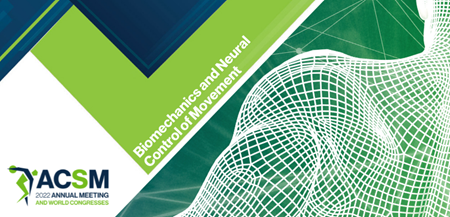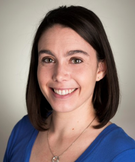Allison H. Gruber, Ph.D., FACSM |
April
5, 2022
The Annual Meeting is BACK and this year we will be in-person in San Diego, CA! I am excited to share with you the interdisciplinary content that will be presented each day of the 2022 ACSM Annual Meeting in the Biomechanics and Neural Control of Movement topical area.
 The Biomechanics and Neural Control of Movement content will kick off on Wednesday, June 1, 9:30 AM – 11:30 AM with a thematic poster session on Running Injury. Our other free communication sessions include: a rapid-fire podium session titled, “Gait Markers of Physical Activity and Health Status” (Thursday, June 2, 9:30 AM – 11:00 AM); a thematic poster session titled, “ACL Injury: Prevention & Rehabilitation Strategies” (Friday, June 3, 9:30 AM – 11:30 AM); a podium session titled, “Aging Interventions” (Friday, June 3, 3:45 PM – 5:45 PM); and 159 posters including poster sessions dedicated to concussions, biomechanics of military health, measuring biomechanics in the wild, sports medicine biomechanics and running performance, among other great topics.
The Biomechanics and Neural Control of Movement content will kick off on Wednesday, June 1, 9:30 AM – 11:30 AM with a thematic poster session on Running Injury. Our other free communication sessions include: a rapid-fire podium session titled, “Gait Markers of Physical Activity and Health Status” (Thursday, June 2, 9:30 AM – 11:00 AM); a thematic poster session titled, “ACL Injury: Prevention & Rehabilitation Strategies” (Friday, June 3, 9:30 AM – 11:30 AM); a podium session titled, “Aging Interventions” (Friday, June 3, 3:45 PM – 5:45 PM); and 159 posters including poster sessions dedicated to concussions, biomechanics of military health, measuring biomechanics in the wild, sports medicine biomechanics and running performance, among other great topics.
Our showcase highlighted symposium this year will be “Extending Human Movement Research from the Lab into the Field,” on Wednesday, June 1, 1:00 – 3:00 PM. Presenters include Clare Milner, Ph.D., FACSM; Robin Queen, Ph.D., FACSM; Emily Matijevich, Ph.D.; and Kellee Hanigan, Ph.D., PT; chaired by Allison Gruber, Ph.D., FACSM. Technological developments in wearable technology have allowed gait biomechanics to be measured in more natural and ecological environments than the laboratory. However, concerns regarding data accuracy often outweigh the potential benefits of using wearables to measure free living gait for clinical and research purposes. This symposium will address these pitfalls by highlighting the technical and practical considerations of using wearable technology to measure gait out-of-the-lab with in-lab quality, validity and precision. Discussion topics also include differences in gait performed in- versus out-of-lab, considerations for data collection and management, estimating internal musculoskeletal loads from externally worn sensors and accounting for missing data. This session is unopposed by other biomechanics and neural control of movement offerings to give everyone the opportunity to attend.
The other symposia and tutorial sessions for the Biomechanics and Neural Control of Movement topical area include sessions presented across other ACSM topical areas and interest groups:
Thursday, June 2, 2:40 – 3:30 PM: “Epidemic of UCL Injuries in Adult and Youth Baseball Pitchers - Causes and Prevention Strategies,” presented by Rafael F. Escamilla, Ph.D., and Arnel Aguinaldo, Ph.D. This colloquium will evaluate elbow biomechanics during pitching as well as UCL rehabilitation and training strategies to decrease UCL injury risk in adult and youth baseball pitchers.
Friday, June 3, 9:30 – 11:30 AM: “Measuring and Modeling Load Carriage,” presented by Anne Silverman, Ph.D.; Kari L. McKenzie, Ph.D.; Jennifer Neugebauer-Sperlein, Ph.D.; and Karen R. Kelly Ph.D.; chaired by Pinata Sessoms, Ph.D. The amount of load carried is only one of many factors that influences musculoskeletal injury risk and physiological performance. Changes in how load is carried or training programs for service members could reduce injury risk. This symposium will present different approaches being used to analyze load carriage related to injury prevention and the unique information each provides with regards to injury prevention and performance.
Saturday, June 4, 8:00 – 8:50 AM: “Treating the Mechanistic Determinants of Muscles Weakness after ACL Injury: Translating the Science into the Clinic,” presented by Lindsey Lepley, Ph.D., ATC, and Riann Palmieri-Smith, Ph.D. ATC. This session will present the mechanisms by which muscle strength is lost after ACL injury and evidence in support of alternative exercise interventions to optimize muscle recovery after injury.
Saturday, June 4, 9:00 – 9:50 AM: “Tai Chi for Fall Prevention - Application and Critical Factors for Success,” presented by Li Li, Ph.D., FACSM. This tutorial lecture will present the scientific basis and the benefits of integrating Tai Chi practice into a fall prevention program for people among a wide spectrum of different groups.
There are several other sessions that will be of interest to biomechanists and motor controlists that are being presented under other topical areas. Two of these great sessions include: “Preventing Bone Stress Injuries in Athletes: What do we Know and What are the Knowledge Gaps?” (Wednesday, June 1, 3:15 PM – 5:15 PM) presented by Stuart Warden, Ph.D, FACSM; Vanessa Yingling, Ph.D., FACSM; Eimear Dolan, Ph.D.; and Craig Sale, Ph.D. (chair); and “Using an Evolutionary Approach in the Prevention of Running Injuries” (Friday, June 3, 3:45 PM – 5:45 PM) presented by Daniel Lieberman, Ph.D.; Adam S. Tenforde, M.D., FACSM; Irene S. Davis, Ph.D., PT, FACSM; and Jacob Hofer, Ph.D (chaired by William O. Roberts, M.D., MS, FACSM).
The Biomechanics Interest Group (BIG) will be hosting their meeting on site, Thursday, June 2. Stay tuned to their website and Twitter for details about the event as they become available. The BIG meeting will include a social event, awards ceremony and a talk by the 2022 ACSM-BIG Career Achievement Award Winner.
Join us at the 2022 Annual Meeting
 Allison H. Gruber, Ph.D., FACSM, is an Associate Professor of Kinesiology in the Indiana University School of Public Health – Bloomington. She is the Topical Representative for Biomechanics and Neural Control of Movement and a previous chairperson of the ACSM Biomechanics Interest Group. Her research interests include the mechanisms of running-related musculoskeletal injuries, wearable technology and using advanced analysis techniques to better understand biomechanical signals for gait analysis. Symposia, tutorial and colloquium summaries were provided by the submitter.
Allison H. Gruber, Ph.D., FACSM, is an Associate Professor of Kinesiology in the Indiana University School of Public Health – Bloomington. She is the Topical Representative for Biomechanics and Neural Control of Movement and a previous chairperson of the ACSM Biomechanics Interest Group. Her research interests include the mechanisms of running-related musculoskeletal injuries, wearable technology and using advanced analysis techniques to better understand biomechanical signals for gait analysis. Symposia, tutorial and colloquium summaries were provided by the submitter.